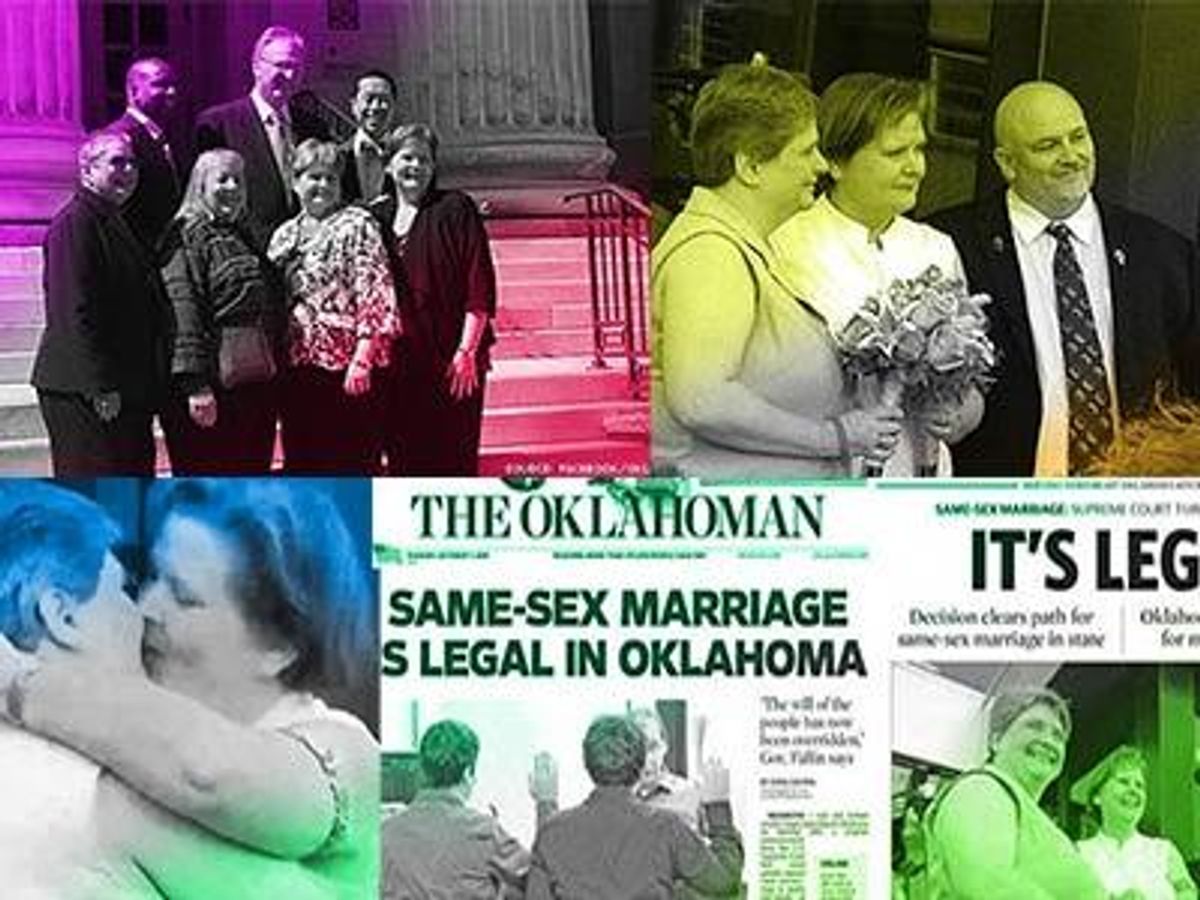
What's Going on in Oklahoma?
Marriage has been legalized in Oklahoma. The U.S. Supreme Court has decided not to take up Oklahoma's marriage equality case.
A decision in Oklahoma has been a long time coming. The state's only marriage case, Bishop v. Smith, was pending since 2004. The case languished for a decade, only moving ahead until the Windsor and Utah decisions in 2013. In early 2014, a U.S. District Court judge found Oklahoma's marriage ban to be unconstitutional. The 10th Circuit Court of Appeals (pictured above) upheld that decision in July.
After losing twice in the Bishop case, the state of Oklahoma petitioned the U.S. Supreme Court for one last chance at upholding its marriage ban, but the court denied its request.
Couples are now marrying in Oklahoma.

What Happens Next?
Because Oklahoma and Utah are both covered by the 10th Circuit Court of Appeals, the Supreme Court's decision means that the lower appellate ruling is now precedent for Colorado, Kansas, New Mexico, and Wyoming.
Marriage is already legal in New Mexico, and Colorado was quick to embrace marriage equality. In Wyoming and Kansas, there are cases pending in federal or state courts, and the governors of both states have pledged to continue fighting to keep their marriage bans. But same-sex couples in Wyoming last week sued for immediate marriage rights in light of the Supreme Court action, and a judge in Kansas's Johnson County, the most populous county in the state, ordered that the county begin issuing marriage licenses to gay and lesbian couples.
Couples could begin obtaining marriage licenses throughout Wyoming and Kansas before the end of the year.

How Do Oklahomans Feel About Marriage?
Not great. A mid-2014 survey showed support at 23 percent and opposition at 66 percent.
Oklahoma has banned marriage for many decades. The legislature first passed a ban in 1975, and then expanded that to prohibit the recognition of out-of-state licenses in 1996. A contitutional ban passed in the legislature and at the ballot box in 2004, by a margin of 75 percent to 25 percent.
The day after the constitutional ban passed, a couple filed the lawsuit that became Bishop v. Smith.

Can Gay and Lesbian Couples Get Married in Oklahoma?
Yes. Previously, only members of the Cheyenne or Arapaho Tribes could marry.
This is the first time that most gay and lesbian Oklahoma residents can marry in their home state. Unlike in nearby Utah, there was no window during which Oklahoma couples could wed.

What Were the Arguments for Marriage Equality?
In their brief to the U.S. Supreme Court, the Oklahoma plaintiffs made just two key points: first, that their case is entitled to enhanced scrutiny; and second, that even if the court didn't use enhanced scrutiny, the marriage ban would still fail under a more permissive examination.
To support their first argument, the plaintiffs pointed out that previous Supreme Court rulings on marriage were broadly applied to all people, rather than just to interracial couples or to inmates. They also cite the Lawrence case in pointing out that the freedom to marry for same-sex couples is not a "new right" but a fundamental matter of liberty.
The petition also cited Windsor, the Ninth Circuit's SmithKline case, and the Iowa Varnum case to bolster their claim that the court should regard discriminatory laws with "skepticism" because the ban is narrowly targeted at gay men and lesbians. In addition, plaintiffs' attorneys wrote, the ban constitutes gender discrimination, citing the Loving decision rejection of "the notion that the mere 'equal application' of a statute containing racial classifications is enough to remove the classifications from the Fourteenth Amendment's proscription of invidious racial discrimination."
In arguing that the ban fails under any standard of review, the plaintiffs pointed out that the supposed justification for the ban -- to promote child rearing by heterosexual couples -- is completely implausible. They compared the case to the landmark Romer case, which found a discriminatory Colorado law to be "so discontinuous with the reasons offered for it" that it cannot pass any standard of review.

What Were the Arguments Against Marriage Equality?
The petitioner in the case was Sally Howe Smith, a court clerk for Tulsa County (pictured above). Smith claimed that the ban is not subject to heightened scrutiny and that it can pass any standard of review.
According to Smith, the right to marry is not "deeply rooted in this Nation's history and tradition."
Incredibly, the state attorneys also claimed that the ban does not distinguish betwen gay and straight people; rather, they say, it distinguishes between same-sex and opposite-sex couples.
The brief also pointed out that the Supreme Court has never held LGBTs to any standard greater than rational basis. Gays and lesbians are not entitled to heightened scrutiny, the state claimed, because they "attract the attention of lawmakers."
Oklahoma cited Windsor as evidence that the Supreme Court should defer to states in matters relating to marriage, and the state also claimed that the law is not rooted in hostility to LGBT people. Attorneys for the state also argued that because the law discriminates equally against men and women, it was not being unfairly executed. The state acknowledged the similarity to the Loving case, in which a racist law was found to be unconstitutional even when applied identically to different races. But, the attorneys claimed, that precedent should not apply here because men and women are physically dissimilar. This is another claim worthy of further examination by sound minds.
























































































